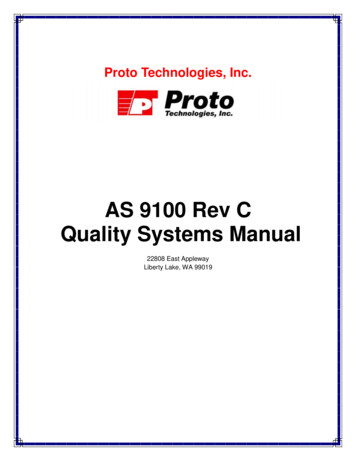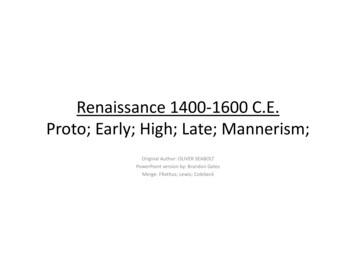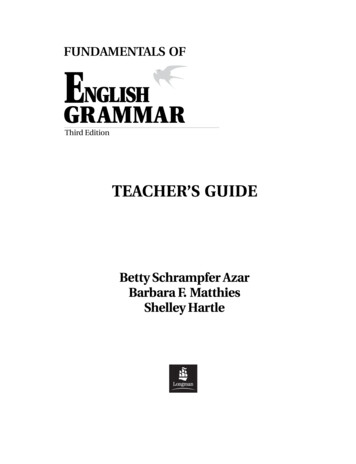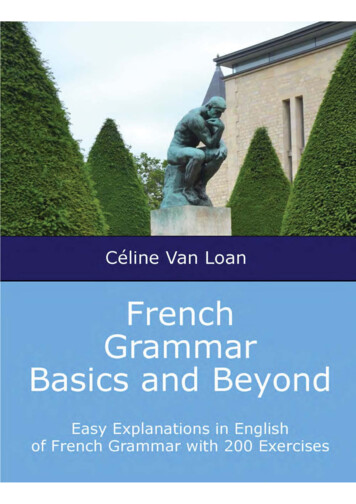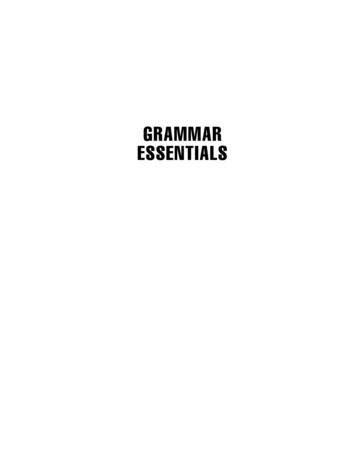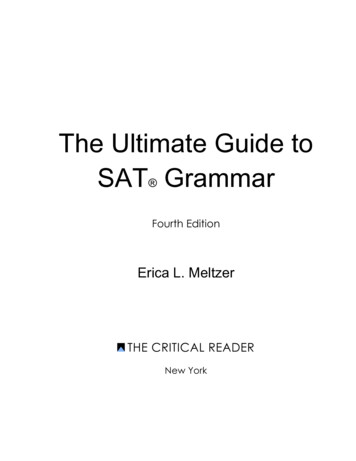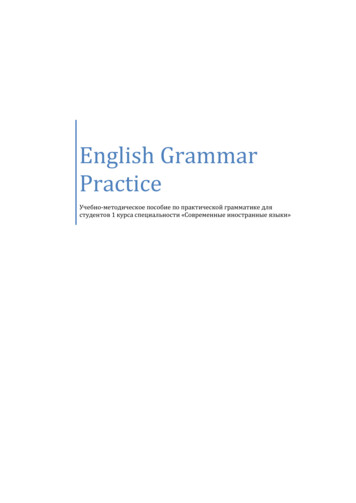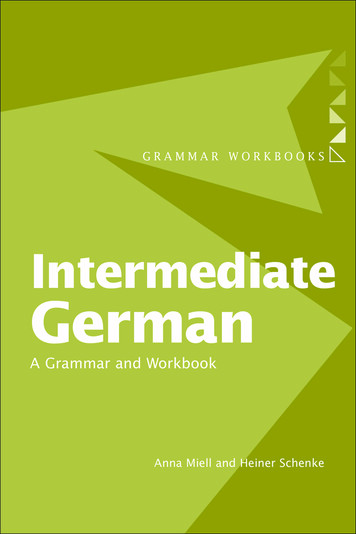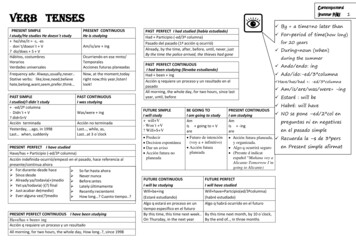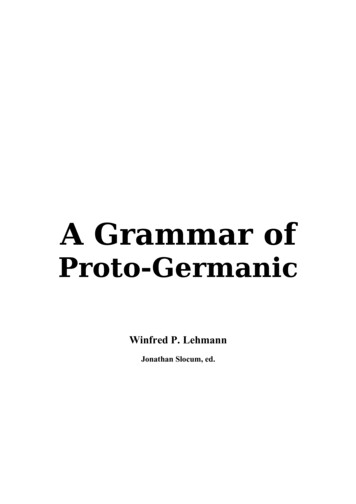
Transcription
A Grammar ofProto-GermanicWinfred P. LehmannJonathan Slocum, ed.
PrefaceThis grammar of Proto-Germanic is designed to provide a comprehensive but concisetreatment of the language from approximately 2500 B.C. to the beginning of our era. Alllinguistic components are taken into consideration. The pragmatic component is dealtwith in the Introduction, and to some extent in chapter six (on semantics and culture), inwhich the semantic component is the major topic; chapters two to five treat thegrammatical component, with separate chapters devoted to phonology, inflectionalmorphology, derivational morphology, and syntax.Discussion of details, as of special forms of words, is kept to a minimum on the groundsthat these are better presented in etymological and other dictionaries, or in editions oftexts. Similarly, only major or distinctive works on the grammar are listed. Treatedsince the early days of historical linguistics in the early nineteenth century, as by JacobGrimm in four large volumes, a full bibliography is enormous; it can be accessedthrough bibliographic journals like those of the Indogermanische Gesellschaft or theModern Language Association as well as the International Linguistic Bibliography.However extensive earlier work may have been, it was devoted almost entirely tophonology and inflectional morphology. Accordingly, Proto-Germanic was notconceived as a whole, nor as a characteristic structure: it was treated as a reflex of theIndo-European reconstructions presented by leading specialists of the past likeBrugmann and Meillet. But, as can scarcely be stated too frequently, Brugmann wasexplicit in pointing out that his Indo-European was not the result of historicalreconstruction but rather a compilation of comparable data in its dialects, especiallySanskrit, Greek and Latin. When Proto-Germanic was related to such a compilation, itwas assumed to be a direct reflex of the material published by Brugmann and othersapplying the same principles, rather than the reflex of an earlier language.We assume a single Germanic language, with a common core of speakers, on the basisof elements common to all its dialects such as ablaut in phonology, comparableinflection of nouns, adjectives, pronouns and verbs, comparable syntactic structure, andcomparable vocabulary (e.g. for kinship terms). We also assume that speakers of itsdialects left that common core at different times, as is clear from linguistic data.Germanic does not reflect the augment, which must have been introduced into IndoIranian, Greek and Armenian after the Indo-European community began breaking up.Accordingly, Brugmann's compilation is based largely on data of a stage that does notapply to Germanic.A realistic reconstruction of Proto-Germanic, then, must be made largely on the basis ofevidence from its dialects. Treatment of that evidence also requires consideration ofsuch matters as the period of time after the flourishing of the proto-language when thedialect was attested, the type of material that has survived, much of which is translatedfrom Greek and Latin, and the body of data, most of which is ecclesiastical. Yet amongthe various proto-languages that have been reconstructed, Proto-Germanic may be oneof the most realistic because of the highly detailed examination of the attested materialover the past two centuries, the relative retention of vocabulary and grammaticalstructure as determined from study of the other Indo-European dialects, and the
relevance of the reconstruction to the civilization as postulated on the basis ofarcheological and historical data.Table of ContentsI. Introduction 1. Introduction1.1. Definition of Proto-Germanic1.2. The Available Data1.3. The Linguistic Methodso 1.3.1. The Comparative Methodo 1.3.2. The Method of Internal Reconstructiono 1.3.3. The Use of Residues1.4. Examination of the Results of such Applications by General or TypologicalPrinciples1.5. Specific Language Typeso 1.5.1. Government and Agreement Languageso 1.5.2. VO and OV Languages1.6. The Phonological Structure of Languages1.7. The Syntactic Structure of Languages1.8. The Semantic Structure of Languages1.9. The Relationship of Germanic to the Other Indo-European Languages1.10. The Development of GermanicII. Phonology 2. Phonology2.1. The Phonological System2.2. The Segmental Phonemes of Proto-Germanic2.3. Relation of the PGmc Segmental Phonemes to those of PIE2.4. Exceptions to the Major Changes of Consonants2.5. Reflexes of the Indo-European Labio-velars2.6. Reflexes of the Indo-European Resonantso 2.6.1. Lengthening of Proto-Germanic /y/ and /w/o 2.6.1a. Evidence for Laryngeals in Proto-Indo-Europeano 2.6.1b. Reflexes of [y w] in Germanic when Adjacent to Laryngealso 2.6.2. Development of PGmc -g- and -k- in the Neighborhood ofLaryngeals with -w2.7. The Late Proto-Germanic Vowel Systemo 2.7.1. The Phonological Status of PGmc [e] and [i]o 2.7.2. The Phonological Status of PGmc [u] and [o]o 2.7.3. The Long Vowel Systemo 2.7.4. Late Proto-Germanic Diphthongs2.8. The Supra-segmentals of Late Proto-Germanico 2.8.1. The Intonation Patterno 2.8.2. The Three Stress Accents
2.8.3. Effect of the Stress on Final Syllables2.9. Morphonologyo 2.9.1. Ablaut and the Laryngealso 2.9.2. Germanic Morphonology as Exemplified in the Verb Systemo 2.9.2a. Vocalic Variationo 2.9.2b. Consonantal Variation2.10. The Conservatism of the Germanic Phonological Systemo III. Inflectional Morphology 3. Inflectional Morphology3.A.1. Introduction on Syntax3.A.2. Inflectional Morphology; Classes of Words3.1. Inflection of Substantives3.2. Inflection of Nounso 3.2.1. The Root Nounso 3.2.2. The Consonant Stemso 3.2.3. The n- stemso 3.2.4. The r- stemso 3.2.5. The nt- stemso 3.2.6. The s- stems3.3. The Vowel Stemso 3.3.1. The o- stemso 3.3.2. The ā- stemso 3.3.3. The yo- and yā- stemso 3.3.4. The wo- and wā- stemso 3.3.5. The i- and u- stemso 3.3.6. Development of Noun Inflection in Proto-Germanic3.4. Inflection of Pronounso 3.4.1. Personal Pronounso 3.4.2. Demonstrative Pronounso 3.4.3. Demonstratives with Further Extensions; Relative Pronounso 3.4.4. The Anaphoric Pronouno 3.4.5. The Interrogative Pronouns3.5. Inflection of Adjectiveso 3.5.1. The Strong Inflection of Adjectiveso 3.5.2. The Weak Inflection of Adjectiveso 3.5.3. The Comparison of Adjectives3.6. The Numerals3.7. Inflection of Verbso 3.7.1. Origin of the Tense Systemo 3.7.2. The Strong Verb Systemo 3.7.3. The Four Classes of Weak Verbs3.8. The Inflected Forms3.9. The Preterite-Presents3.10. The Uses of the FormsIV. Derivational Morphology
4. Derivational Morphology4.1. Types of Affixed Nominals by Meaning4.2. Forms of Nominal Suffixeso 4.2.1. Derivation with Reflexes of -t- and Accompanying Vowelso 4.2.2. Derivation with Reflexes of -jo 4.2.3. Derivation with Reflexes of -no 4.2.4. Derivation with Reflexes of -lo 4.2.5. Derivation with Reflexes of -ro 4.2.6. Derivation with Reflexes of Further Suffixeso 4.2.7. Derivation with Nouns as Suffixes4.3. Verbal Suffixes and the Bases to which they were Addedo 4.3.1. Additional Suffixes4.4. Derivation of Verbs by Means of Prefixes4.5. Derivation of Nouns by Means of Prefixes4.6. Compound Nouns4.7. Pronominal Compounds4.8. Derivation of Adjectives in Comparison4.9. Formation of Adverbs from Adjectives4.10. Conclusion: Types of Derivation and Their Semantic DevelopmentV. Syntax 5. Syntax5.1. Structure of the Sentence as SOVo 5.1.1. Evidence for OV Order in Simple Clauseso 5.1.2. Order in Comparative Constructionso 5.1.3. The Use of Postpositionso 5.1.4. Placement of Titles after Proper Nameso 5.1.5. Word Order in Equational Sentenceso 5.1.6. Evidence in Modifying Constructionso 5.1.6a. Relative Clauses Indicated by Particleso 5.1.6b. Demonstrative Pronouns Used to Introduce Relative Clauseso 5.1.7. The Use of Limiting Adjectives in Weak Inflectiono 5.1.8. OV Order for Adjectives and Genitiveso 5.1.9. Word Order in Marked Constructions5.2. The Word Order of Questions5.3. Subordinate Clauses and Compound Sentenceso 5.3.1. Relative Clauseso 5.3.2. Participial Constructions Comparable to Relative Clauseso 5.3.3. Object and Adverbial Clauses5.4. Expression of Negation5.5. Expression of Voice: Middle and Passive Constructions5.6. Expression of Tense and Aspect5.7. Expression of Uncertainty and Modalityo 5.7.1. Expression of Possibilityo 5.7.2. Voluntative Expressionso 5.7.3. Expression of Obligation or Necessityo 5.7.4. Expression of Causationo 5.7.5. Expression of Command
5.8. Sentence Adverbials5.9. The Germanic Sentence Structure and its DevelopmentVI. Semantics and Culture 6. Semantics and Culture6.1. The Culture of the Speakers of Proto-Germanico 6.1.1. Religiono 6.1.2. Economic and Personal Practices6.2. The Kinship System and Family Structure6.3. The Household6.4. Construction6.5. Occupations6.6. The Economyo 6.6.1. The Numeralso 6.6.2. The Way of Life of the Germanic Peoples6.7. The Plant World6.8. Nature6.9. Words for Transportation6.10. Conclusions on the Bearing of the Semantic Structure of PGmc forEvidence on the Culture of the SpeakersVII. Texts 7. Texts7.1. Gothic7.2. Old English7.3. Old Saxon7.4. Old High German7.5. Old Norse / IcelandicA. Bibliography A. Bibliography
I. INTRODUCTION1.1. Definition of Proto-GermanicProto-Germanic (PGmc) is the reconstructed language from which the attestedGermanic dialects developed; chief among these are Gothic (Go.) representing EastGermanic, Old Norse (ON) representing North Germanic, and Old English (OE), OldSaxon (OS), and Old High German (OHG) representing West Germanic. PGmc isdistinguished from the other Indo-European languages by phonological innovationssuch as the change of consonants characterized by Grimm's Law, by morphologicalinnovations such as the introduction of the dental preterite and the n- declension ofadjectives, by syntactic innovations such as the large number of modal auxiliaries, andby numerous additions to its lexicon.As a reconstructed language, Proto-Germanic is not attested in texts; the material onwhich it is based is found in the attested dialects that developed from it. A yet earlierstage, reconstructed as Proto-Indo-European (PIE), includes means to account for andalso to explain the reconstruction. That is to say, the beginnings of PGmc are assumedto overlap with the late stages of PIE, and data from later developments in Germanicdialects compared with evidence from PIE provides the basis for a grammar of PGmccomparable to those for languages spoken today, if not so detailed. PGmc may be datedfrom approximately 2500 B.C. to the beginning of our era, a period during which itunderwent numerous changes.Our grammar is arranged in three traditional systems: the phonological system (chapter 2);the syntactic system (chapters 3, 4, 5);the semantic system (chapter 6).The semantic system is presented in relation to the cultural context of the reconstructedlanguage.Our knowledge of the phonological system and of the morphological component of thesyntactic system is relatively good because much of the energy devoted to Germaniclinguistics in the nineteenth and twentieth centuries was directed at these areas.Sentence patterns and the semantic system have received far less treatment; as a result,presentation of these requires considerable attention, especially their interpretation inaccordance with general linguistic principles that have been developed in recent years.While the resulting grammar of Proto-Germanic may be less assured in some respectsthan are grammars of attested languages, it is represented here in compact form on thebasis of the available data.1.2. The Available Data
The only textual material contemporary with [late] Proto-Germanic is recorded inclassical authors, or maintained in borrowings into other languages as exemplified byFinnish kuningas 'king'. Classical texts chiefly include proper names, such asKhariomēros in Greek and Langobardi in Latin texts. This material has been assembledand interpreted, as by Kluge (1913:5-47). Also important are the earliest Runicinscriptions; while they tend to be longer than the discrete Germanic items recorded inother languages, they are restricted in content and structure. Their language is archaic,though many can be dated only a few centuries before the time of other materialsrecorded in Germanic dialects such as Old English; few precede the time of our Gothictexts.These materials provide the earliest data, but the most comprehensive data are providedin texts of Gothic, Old Norse/Old Icelandic, Old English, Old Saxon, and Old HighGerman written in the first millennium A.D. Other dialects, such as Old Frisian, havefewer materials. The modern Germanic languages have generally developed so far fromProto-Germanic that they provide little evidence for its description; for most purposes,only the earliest texts can be used. In the reconstruction of the phonological system,morphologically isolated forms in the "everyday vocabulary" are highly important. Anexample is Go. faíhu, ON fé, OE feoh, OS fehu, OHG fehu 'cattle', on the basis of whichPGmc fehu is reconstructed. When possible, as here, the reconstruction is shown withcomparable forms in other languages, such as Lat. pecu 'herd', Skt páśu, Lith. pekus.Inflected forms in the everyday vocabulary are similarly important for reconstructingthe morphological system; among these are verbs like ON bīta, OE bītan, OS bītan,OHG bītan 'bite' and Go. (and-)beitan, 3rd sg. pret. and-bait, 3rd pl. pret. and-bitan,past ptc. and-bitans. On the basis of these, PGmc bītan- and comparable forms arereconstructed and supported by cognates such as Gk pheídomai 'I separate'. Anotherexample is Go. bairan, bar, baurun, baurans, and comparable forms for ON bera, OEberan, OS beran, OHG beran, from which PGmc beran and the other forms arereconstructed, supported by cognates such as Lat. ferō 'I bear'. For these and otherverbs, as well as nouns, adjectives and pro
This grammar of Proto-Germanic is designed to provide a comprehensive but concise treatment of the language from approximately 2500 B.C. to the beginning of our era. All linguistic components are taken into consideration. The pragmatic component is dealt with in the Introduction, and to some extent in chapter six (on semantics and culture), in which the semantic component is the major topic .
